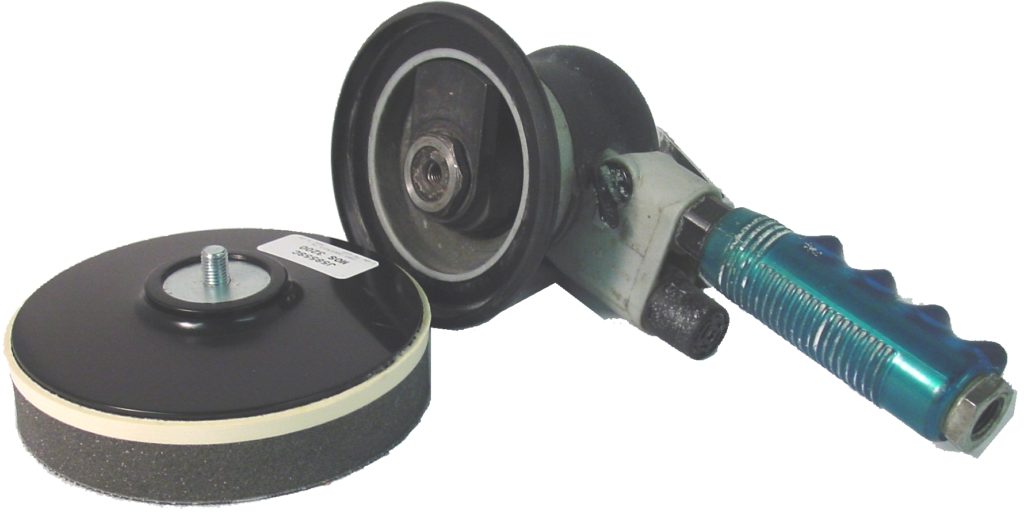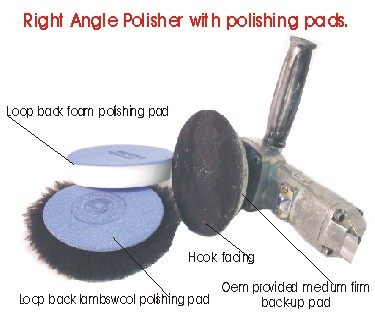WE DO NOT INCLUDE POWER TOOLS WITH OUR KITS
For our “mechanical” kits: Heavy Damage Removal Kit, Light Damage Removal Kit, Maintenance Kit, Polycarbonate Kit, Leading Edge Kit, Clearseas Acrylic Kit and Clearseas Vinyl Kit, you will need power tools that are not sold with our kits. Not including tools allows us to keep the price of the kits to a minimum.
TOOLS FOR SANDING
For best results, we suggest using a RANDOM ORBITAL sander for the sanding portion of the process. The exception to this rule is when using our Leading Edge Kit – for this kit, you will only use a rotary polishing buffer.
RANDOM ORBITAL sanders are also know as DUAL ACTION sanders. The sanding head spins in a random pattern making blending easier. These are also referred to as “finishing” sanders.
The random orbital that you choose to use needs to be rated at approximately 10000 RPMs and needs to have variable speed options. You will actually adjust the sander down in speed, approximately half way or until you can easily control it with one hand. You will need the 10000 RPMs for power, but the lower variable speed for control as you work.

TOOLS FOR BUFFING
The buffing portion of the restoral process is performed using a right angle polisher. This is also known as a rotary buffer. This is the same type of buffer you would use on your automobile to buff the clear coat paint. The pad spins in a stationary orbit.
The buffer that you choose to use should be rated at approximately 2500 RPMs. It is important to keep in this range so that you have enough power to do the job, but not so high of RPMs that you would generate a great deal of heat. It is easier to generate heat with a polisher than with a sander. Heat generation can cause distortion, orange peel, and burning. This is why it is important to always use lubrication, preferably water, when possible.
Unlike with the sanding portion of the process, for most jobs, the standard back-up pad that comes with your buffer will be sufficient to do the job. If you’re working on a particularly soft material or are having problems reaching a high gloss finish, then attach an interface pad onto your standard backup pad to give yourself the necessary added cushioning. Most industrial supply stores will carry inexpensive, 5″ interface pads. Remember to purchase one that is “Loop to Hook” meaning, the loop on one side of the interface pad connects to the hook facing of your standard buffer and the hook side of the interface will be what you attach your loop backed polishing pads to.

All of our kits are supplied with accessories to fit 5″ tools. All the Micro- Mesh™ discs and polishing pads are supplied with LOOP backing so you can get the most value from each kit. All discs and pads can be washed and used over and over.
Sanders and buffers are available as both pneumatic (air) and electric. **We always caution people when using electric tools on wet surfaces.
BACKUP PADS
Your sander and/or buffer come with a standard “backup pad” when you purchase it. This back-up pad is what you attach the Micro-Mesh™ sanding disc or polishing pad to. The back-up pad is sometimes referred to as a “backing plate” or “sanding pad”, depending on who you speak with. We refer to it as a “backup pad.” This pad is made of foam and has either a “hook” surface or “smooth” surface on which to apply the sanding discs or polishing pads. If you have a back-up pad with “hook” you will need to attach LOOP backed sanding discs. If you have a back-up pad with a “smooth” face, you would attach PSA (pressure sensitive adhesive)backed discs.
The foam in the backup pad on most sanders and buffers that come standard on your tool are usually medium to hard in density. Our mechanical kits all feature our specially made extra soft back-up pad. This back-up pad will easily conform to curvatures and allow you to polish your part to a high gloss finish. The harder the backup pad the more in contact you will be with the part you are finishing and provide a coarser cutting action. This is not what you need when polishing softer material to a high gloss finish. The softer the back-up pad, the easier it will polish.
The back-up pad included with our kit has a male shank with a 5/16″ x 24 thread count. There are many good sanders on the market today that will fit this back-up pad. We do not recommend one sander over another.
WHEN AND IF TO USE A CORDLESS DRILL
If you’re uncomfortable using power tools or do not have access to air or electricity hook-up, you can use a cordless drill for both the sanding and buffing portions of our restoral process, with satisfactory results.
The exception to this rule would be when using our HEAVY DAMAGE REMOVAL KIT. Any sanding done coarser than with our MICRO-MESH™ 1500 requires that you use a random orbital sander. A cordless drill simply does not have the power you need for coarse sanding.
We recommend that you have a cordless drill that is completely charged and an extra battery set to go prior to beginning your work. We also caution that when in use, keep the drill parrallel to the workpiece at all times and adjust the speed so that the drill provides a smooth action. Any “skipping” or “jumping” on the work piece will cause “chatter” marks.
The Light Damage Removal, Maintenace and Clearseas Vinyl and Acrylic kits are available with a special, extra soft back-up pad that is on a mandrell that will fit into your cordless drill. This is provided in the kit. You will have to choose the Light Damage Removal DRILL Kit in order to get this back-up pad. If you order the Light Damage Removal Kit – you will receive a back-up pad for a random orbital sander. The same is true for the Maintenance Kit. Make sure and look at the back-up pad in the picture of the kit you are purchasing to make sure you’re getting the correct one.

